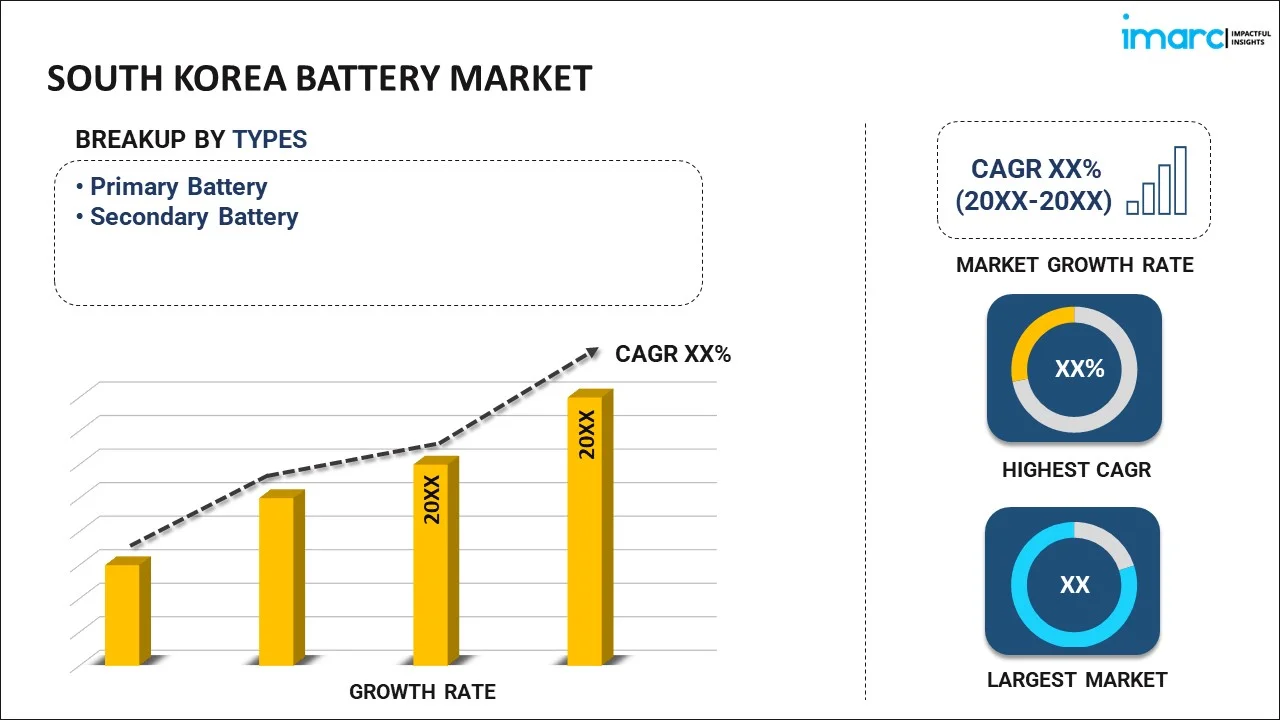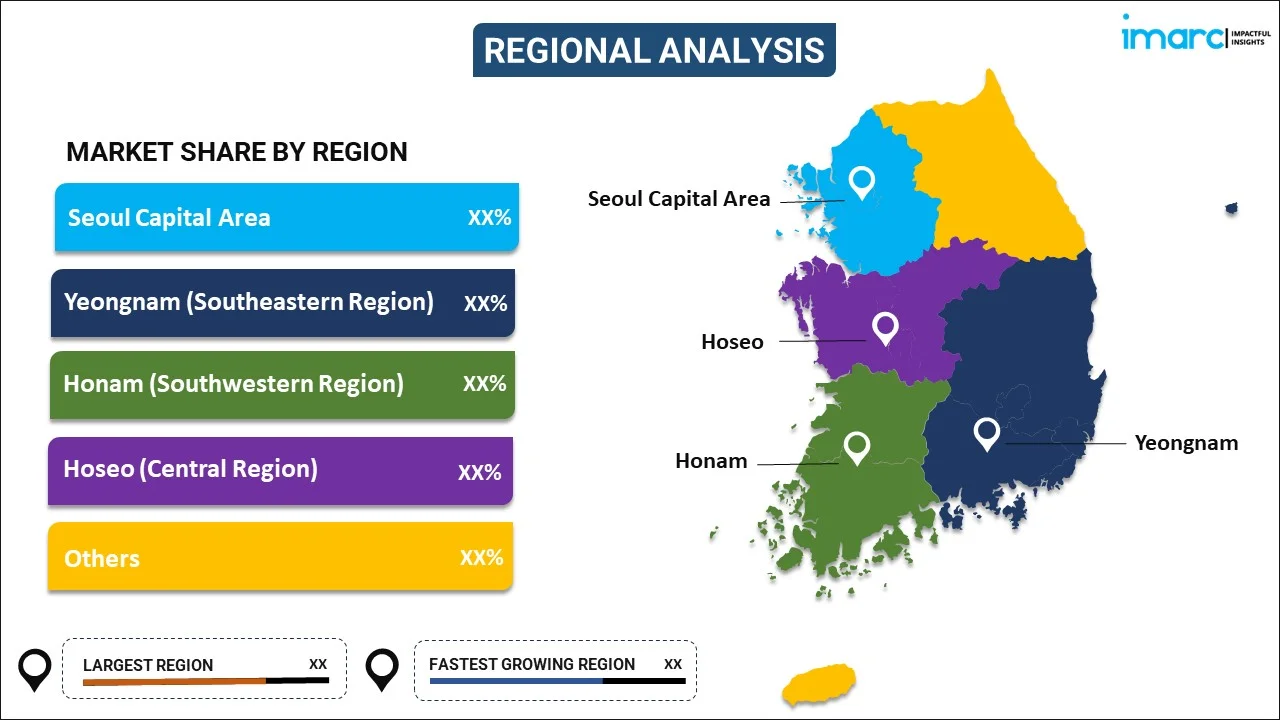
South Korea Battery Market Report by Type (Primary Battery, Secondary Battery), Product (Lithium-Ion, Lead Acid, Nickel Metal Hydride, Nickel Cadmium, and Others), Application (Automotive Batteries, Industrial Batteries, Portable Batteries), and Region 2024-2032
South Korea Battery Market:
South Korea battery market size is projected to exhibit a growth rate (CAGR) of 18.90% during 2024-2032. The rapid expansion of electric vehicles and innovations in energy storage technologies are stimulating the market in the country.
|
Report Attribute
|
Key Statistics
|
|---|---|
|
Base Year
|
2023 |
|
Forecast Years
|
2024-2032
|
|
Historical Years
|
2018-2023
|
| Market Growth Rate (2024-2032) | 18.90% |
South Korea Battery Market Analysis:
- Major Market Drivers: The increasing use of renewable energy in South Korea requires efficient battery storage solutions to manage intermittent power supply, thereby encouraging the market expansion.
- Key Market Trends: South Korea's focus on smart grids and energy management systems promotes the development of high-performance batteries, enhancing grid reliability and resilience and thereby accelerating the market growth.
- Competitive Landscape: The report has provided a comprehensive analysis of the competitive landscape in the market. Also, detailed profiles of all major companies have been provided.
- Geographical Trends: According to the South Korea battery market analysis report, the Seoul Capital Area leads in R&D activities and manufacturing facilities. Besides this, Yeongnam focuses on automotive battery production. In contrast, Honam supports renewable energy storage solutions, and Hoseo emphasizes smart grid technology, while other regions are developing niche battery technologies and infrastructure for growth.
- Challenges and Opportunities: The dependency on imported raw materials is hindering market growth. However, investing in local recycling facilities and fostering domestic material production capabilities will continue to bolster the market over the forecasted period.
South Korea Battery Market Trends:
Increased Investment in Battery Manufacturing Technology
South Korea is investing in developing next-generation technologies, such as solid-state and cobalt-free batteries. This strategy aims to advance the region's technological capabilities, reduce dependency on traditional battery materials, and enhance competitiveness against rivals, especially in a rapidly evolving energy landscape. For example, in April 2024, South Korea announced an approximately US$15 Billion investment in the rechargeable battery sector by 2030. This initiative aims to enhance technological advancements, including next-generation batteries, and strengthen the country's competitive edge in battery manufacturing and exports.
Growing Focus on Battery Safety Regulations
The region is enhancing battery safety measures following recent EV fires. New regulations require more stringent certification processes, disclosure of battery manufacturers, and improved fire prevention strategies. This is expanding the South Korea battery market demand. These efforts aim to increase consumer trust and ensure the safe expansion of battery usage in the local market. For instance, in August 2024, government bodies in South Korea advanced its electric vehicle battery certification scheme due to recent EV fires. The updated regulations aim to improve battery safety standards and require automakers to enhance fire prevention measures.
Expansion of Production Capacity and Export Capabilities
South Korea is significantly expanding its battery production capacity to meet rising demand, particularly for electric vehicles. The region aims to enhance its supply chain resilience, boost exports, and solidify its position as a key player in the market by increasing output and establishing new plants domestically and abroad. For example, in May 2024, Webasto expanded its EV battery pack production in Dangjin, South Korea, increasing its annual capacity to 300,000 packs by 2025. This expansion, driven by growing EV demand, enhances production capabilities and supports the electrification efforts in the region.
South Korea Battery Industry Segmentation:
IMARC Group provides an analysis of the key trends in each segment of the market, along with the South Korea battery market forecasts at the country and regional levels for 2024-2032. Our report has categorized the market based on the type, product, and application.
Breakup by Type:

- Primary Battery
- Secondary Battery
The report has provided a detailed breakup and analysis of the market based on the type. This includes the primary battery and secondary battery.
South Korea focuses on developing both primary and secondary batteries to meet diverse energy needs. Primary batteries, like alkaline types, are used in small electronics. In contrast, secondary batteries, including lithium-ion, are essential for rechargeable applications such as electric vehicles and energy storage systems, reflecting the region's technological advancements. This is elevating the South Korea battery market share.
Breakup by Product:
- Lithium-Ion
- Lead Acid
- Nickel Metal Hydride
- Nickel Cadmium
- Others
The report has provided a detailed breakup and analysis of the market based on the product. This includes lithium-ion, lead acid, nickel metal hydride, nickel cadmium, and others.
South Korea utilizes a variety of battery technologies, including lithium-ion, lead-acid, nickel metal hydride, and nickel-cadmium. Each type serves different applications, from electric vehicles to renewable energy storage. The South Korea battery market outlook emphasizes improving performance, safety, and sustainability to meet diverse energy needs and reduce environmental impact.
Breakup by Application:
- Automotive Batteries
- Industrial Batteries
- Portable Batteries
The report has provided a detailed breakup and analysis of the market based on the application. This includes automotive batteries, industrial batteries, and portable batteries.
South Korea is a leader in battery technology, producing advanced automotive, industrial, and portable batteries. Its expertise in lithium-ion technology enhances electric vehicles, powers industrial equipment, and supports consumer electronics, thereby reflecting a commitment to innovation and energy efficiency in the regional market.
Breakup by Region:

- Seoul Capital Area
- Yeongnam (Southeastern Region)
- Honam (Southwestern Region)
- Hoseo (Central Region)
- Others
The report has also provided a comprehensive analysis of all the major regional markets, which include Seoul Capital Area, Yeongnam (Southeastern Region), Honam (Southwestern Region), Hoseo (Central Region), and others.
In South Korea, the Seoul Capital Area is a key hub for automotive battery technology, driving research and innovation. Moreover, the Yeongnam region excels in large-scale battery production, making it a central manufacturing site. According to the South Korea battery market outlook report, Honam focuses on high-performance batteries, contributing to advanced solutions for various applications. Meanwhile, Hoseo supports emerging technologies, ensuring the continuous development of the country's battery industry. Each region's unique strengths collectively enhance South Korea's position in the battery market.
Competitive Landscape:
The South Korea battery market research report has also provided a comprehensive analysis of the competitive landscape in the market. Competitive analysis, such as market structure, key player positioning, top winning strategies, competitive dashboard, and company evaluation quadrant, has been covered in the report. Also, detailed profiles of all major companies have been provided.
South Korea Battery Market Recent Developments:
- August 2024: Government bodies in South Korea advanced its electric vehicle battery certification scheme due to recent EV fires. The updated regulations aim to improve battery safety standards and require automakers to enhance fire prevention measures.
- May 2024: Webasto expanded its EV battery pack production in Dangjin, South Korea, increasing its annual capacity to 300,000 packs by 2025. This expansion, driven by growing EV demand, enhances production capabilities and supports the electrification efforts in the region.
- April 2024: South Korea announced an approximately US$15 Billion investment in the rechargeable battery sector by 2030 to strengthen the country's competitive edge in battery manufacturing and exports.
South Korea Battery Market Report:
| Report Features | Details |
|---|---|
| Base Year of the Analysis | 2023 |
| Historical Period | 2018-2023 |
| Forecast Period | 2024-2032 |
| Units | Billion US$ |
| Scope of the Report | Exploration of Historical Trends and Market Outlook, Industry Catalysts and Challenges, Segment-Wise Historical and Predictive Market Assessment:
|
| Types Covered | Primary Battery, Secondary Battery |
| Products Covered | Lithium-Ion, Lead Acid, Nickel Metal Hydride, Nickel Cadmium, Others |
| Applications Covered | Automotive Batteries, Industrial Batteries, Portable Batteries |
| Regions Covered | Seoul Capital Area, Yeongnam (Southeastern Region), Honam (Southwestern Region), Hoseo (Central Region), Others |
| Customization Scope | 10% Free Customization |
| Report Price and Purchase Option | Single User License: US$ 3699 Five User License: US$ 4699 Corporate License: US$ 5699 |
| Post-Sale Analyst Support | 10-12 Weeks |
| Delivery Format | PDF and Excel through Email (We can also provide the editable version of the report in PPT/Word format on special request) |
Key Questions Answered in This Report:
- How has the South Korea battery market performed so far, and how will it perform in the coming years?
- What has been the impact of COVID-19 on the South Korea battery market growth?
- What is the breakup of the South Korea battery market on the basis of type?
- What is the breakup of the South Korea battery market on the basis of product?
- What is the breakup of the South Korea battery market on the basis of application?
- What are the various stages in the value chain of the South Korea battery market?
- What are the key driving factors and challenges in the South Korea battery?
- What is the structure of the South Korea battery market, and who are the key players?
- What is the degree of competition in the South Korea battery market?
Key Benefits for Stakeholders:
- IMARC’s industry report offers a comprehensive quantitative analysis of various market segments, historical and current market trends, market forecasts, and dynamics of the South Korea battery market from 2018-2032.
- The research report provides the latest information on the market drivers, challenges, and opportunities in the South Korea battery market.
- The study maps the leading, as well as the fastest-growing, markets. It further enables stakeholders to identify the key country-level markets within the region.
- Porter's five forces analysis assists stakeholders in assessing the impact of new entrants, competitive rivalry, supplier power, buyer power, and the threat of substitution. It helps stakeholders to analyze the level of competition within the South Korea battery industry and its attractiveness.
- The competitive landscape allows stakeholders to understand their competitive environment and provides insight into the current positions of key players in the market.
Need more help?
- Speak to our experienced analysts for insights on the current market scenarios.
- Include additional segments and countries to customize the report as per your requirement.
- Gain an unparalleled competitive advantage in your domain by understanding how to utilize the report and positively impacting your operations and revenue.
- For further assistance, please connect with our analysts.
 Inquire Before Buying
Inquire Before Buying
 Speak to an Analyst
Speak to an Analyst
 Request Brochure
Request Brochure
 Request Customization
Request Customization




.webp)




.webp)












